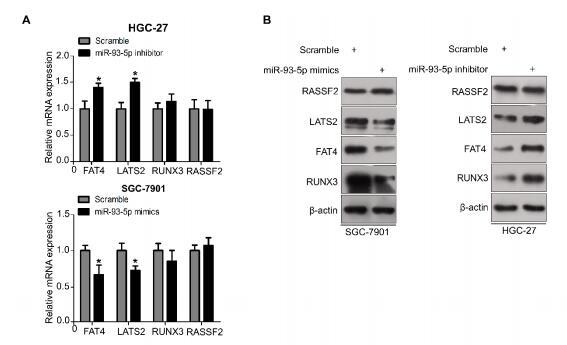RUNX3 Antibody - #AF5188
| Product: | RUNX3 Antibody |
| Catalog: | AF5188 |
| Description: | Rabbit polyclonal antibody to RUNX3 |
| Application: | WB IHC IF/ICC |
| Cited expt.: | WB |
| Reactivity: | Human, Mouse |
| Prediction: | Pig, Bovine, Horse, Rabbit, Dog, Xenopus |
| Mol.Wt.: | 44 kDa; 44kD(Calculated). |
| Uniprot: | Q13761 |
| RRID: | AB_2837674 |
Related Downloads
Protocols
Product Info
*The optimal dilutions should be determined by the end user. For optimal experimental results, antibody reuse is not recommended.
*Tips:
WB: For western blot detection of denatured protein samples. IHC: For immunohistochemical detection of paraffin sections (IHC-p) or frozen sections (IHC-f) of tissue samples. IF/ICC: For immunofluorescence detection of cell samples. ELISA(peptide): For ELISA detection of antigenic peptide.
Cite Format: Affinity Biosciences Cat# AF5188, RRID:AB_2837674.
Fold/Unfold
Acute myeloid leukemia 2 protein; Acute myeloid leukemia gene 2; AML 2; AML2; CBF alpha 3; CBF-alpha-3; CBFA 3; CBFA3; Core binding factor alpha 3 subunit; core binding factor; Core binding factor runt domain alpha subunit 3; Core binding factor subunit alpha 3; core-binding factor; Core-binding factor subunit alpha-3; Oncogene AML 2; Oncogene AML-2; PEA2 alpha C; PEA2-alpha C; PEBP2 alpha C; PEBP2-alpha C; Pebp2a3; PEBP2aC; Polyomavirus enhancer binding protein 2 alpha C subunit; Polyomavirus enhancer-binding protein 2 alpha C subunit; runt domain alpha subunit 3; runt related transcription factor 3; Runt-related transcription factor 3; RUNX 3; Runx3; RUNX3_HUMAN; SL3 3 enhancer factor 1 alpha C subunit; SL3-3 enhancer factor 1 alpha C subunit; SL3/AKV core binding factor alpha C subunit; SL3/AKV core-binding factor alpha C subunit; Transcription factor AML2;
Immunogens
A synthesized peptide derived from human RUNX3, corresponding to a region within the internal amino acids.
- Q13761 RUNX3_HUMAN:
- Protein BLAST With
- NCBI/
- ExPASy/
- Uniprot
MRIPVDPSTSRRFTPPSPAFPCGGGGGKMGENSGALSAQAAVGPGGRARPEVRSMVDVLADHAGELVRTDSPNFLCSVLPSHWRCNKTLPVAFKVVALGDVPDGTVVTVMAGNDENYSAELRNASAVMKNQVARFNDLRFVGRSGRGKSFTLTITVFTNPTQVATYHRAIKVTVDGPREPRRHRQKLEDQTKPFPDRFGDLERLRMRVTPSTPSPRGSLSTTSHFSSQPQTPIQGTSELNPFSDPRQFDRSFPTLPTLTESRFPDPRMHYPGAMSAAFPYSATPSGTSISSLSVAGMPATSRFHHTYLPPPYPGAPQNQSGPFQANPSPYHLYYGTSSGSYQFSMVAGSSSGGDRSPTRMLASCTSSAASVAAGNLMNPSLGGQSDGVEADGSHSNSPTALSTPGRMDEAVWRPY
Predictions
Score>80(red) has high confidence and is suggested to be used for WB detection. *The prediction model is mainly based on the alignment of immunogen sequences, the results are for reference only, not as the basis of quality assurance.
High(score>80) Medium(80>score>50) Low(score<50) No confidence
Research Backgrounds
Forms the heterodimeric complex core-binding factor (CBF) with CBFB. RUNX members modulate the transcription of their target genes through recognizing the core consensus binding sequence 5'-TGTGGT-3', or very rarely, 5'-TGCGGT-3', within their regulatory regions via their runt domain, while CBFB is a non-DNA-binding regulatory subunit that allosterically enhances the sequence-specific DNA-binding capacity of RUNX. The heterodimers bind to the core site of a number of enhancers and promoters, including murine leukemia virus, polyomavirus enhancer, T-cell receptor enhancers, LCK, IL3 and GM-CSF promoters (By similarity). May be involved in the control of cellular proliferation and/or differentiation. In association with ZFHX3, upregulates CDKN1A promoter activity following TGF-beta stimulation. CBF complexes repress ZBTB7B transcription factor during cytotoxic (CD8+) T cell development. They bind to RUNX-binding sequence within the ZBTB7B locus acting as transcriptional silencer and allowing for cytotoxic T cell differentiation. CBF complexes binding to the transcriptional silencer is essential for recruitment of nuclear protein complexes that catalyze epigenetic modifications to establish epigenetic ZBTB7B silencing (By similarity).
Phosphorylated on tyrosine residues by SRC. Phosphorylated by LCK and FYN.
Nucleus. Cytoplasm.
Note: The tyrosine phosphorylated form localizes to the cytoplasm. Translocates from the cytoplasm to the nucleus following TGF-beta stimulation.
Expressed in gastric cancer tissues (at protein level).
A proline/serine/threonine rich region at the C-terminus is necessary for transcriptional activation of target genes.
Research Fields
· Organismal Systems > Immune system > Th1 and Th2 cell differentiation. (View pathway)
References
Application: WB Species: human Sample:
Restrictive clause
Affinity Biosciences tests all products strictly. Citations are provided as a resource for additional applications that have not been validated by Affinity Biosciences. Please choose the appropriate format for each application and consult Materials and Methods sections for additional details about the use of any product in these publications.
For Research Use Only.
Not for use in diagnostic or therapeutic procedures. Not for resale. Not for distribution without written consent. Affinity Biosciences will not be held responsible for patent infringement or other violations that may occur with the use of our products. Affinity Biosciences, Affinity Biosciences Logo and all other trademarks are the property of Affinity Biosciences LTD.


